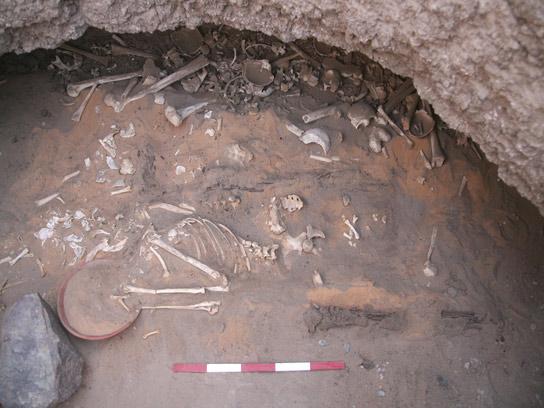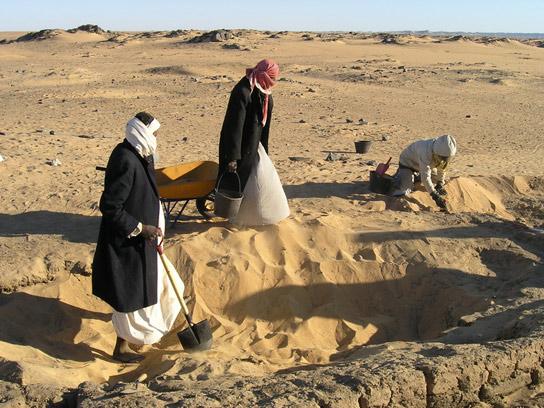Amara West 2012: looking back on the season in the cemetery
Michaela Binder / Durham University
Source - http://blog.britishmuseum.org/2012/03/19/amara-west-2012-looking-back-on-the-season-in-the-cemetery/
After seven weeks of excavation we can look back to a very successful season in the cemetery at Amara West. In total, the two field school members (Åshild Vagene and Mohamed Saad), Laurel Engbring, Milena Grybowska and I were able to excavate and document 11 graves.
 Multiple burials in the eastern chamber of G314
Multiple burials in the eastern chamber of G314
All of them proved to be complex features with one or two burial chambers used for the interment of several individuals – up to 15 in the case of G314. But even though the general outline of the graves appears similar, they differ from each other considerably in terms of size, shape and orientation. The results of this season confirm our picture of a mixed culture combining elements of Nubian and Egyptian funerary customs.

Copper alloy mirror (F8448) found within G309
G309, the newly discovered pyramid tomb, attests to the wealth of some individuals living at Amara West. The use of a pyramid superstructure, the decorated coffin and a copper alloy mirror, only discovered on the very last day of the season, show that the people buried in this grave chose to be buried surrounded by recognisably Pharaonic objects and architecture. However, this does not prove they were Egyptians – they could also have been acculturated Nubians, or descendants of intermarriage between Egyptians and Nubians.
The discovery of an Early or Middle Kerma tumulus, dug by Åshild and Mohamed, shows that the area of Amara West had already been occupied long before the establishment of the Egyptian town. Even though the site of settlement changed, the inhabitants of the Pharaonic settlement chose to use the same burial grounds, which would have been demarcated by the prominent Kerma tumuli back then just as they are today. Was the cemetery placed here, over a Kerma burial ground, to underline Egyptian domination of the area perhaps?

Excavation area – Due to the strong wind the graves had to be covered with tarpaulin for most of the season
The preservation of organic remains allows for more refined insights into funerary customs during the New Kingdom and post-New Kingdom period. As an example, we can differentiate different types of funerary containers such as coffins, different mats, textiles and burial beds.

Abdu Yassin, Hassan Awad and Milena Grybowska excavating in G309
The coming months will see work on the large amount of drawings, notes and context sheets, while the human remains excavated this season are already on their way to London where I will again spend a few months studying them. This time I will be joined by Åshild and Mohamed for two weeks as part of the field school project.
Many thanks to the excavators, workmen and everyone else who helped make 2012 a very successful season.